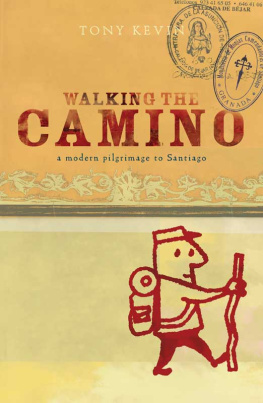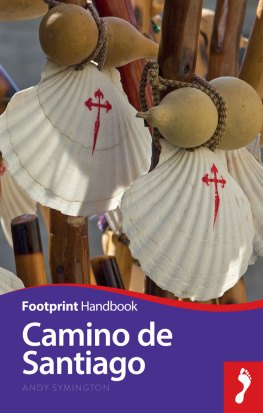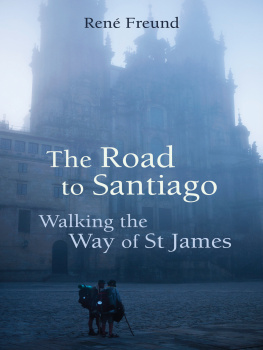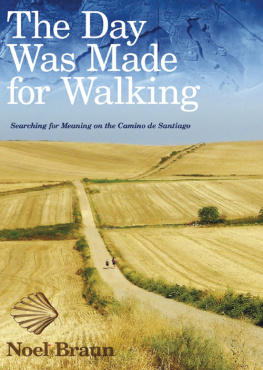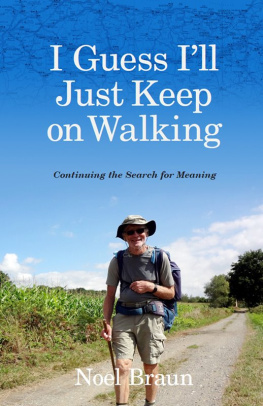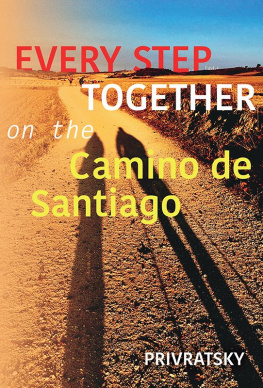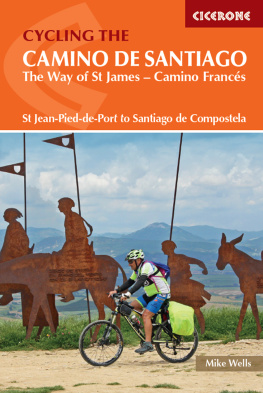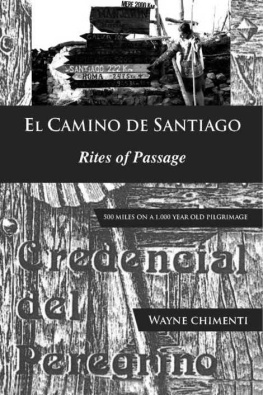Scribe Publications
WALKING THE CAMINO
Tony Kevin retired from the Australian foreign service in 1998, after a 30-year government career during which he served in the Foreign Affairs and Prime Ministers departments, and was Australias ambassador to Poland and Cambodia. He is currently an honorary visiting fellow at the Australian National Universitys Research School of Pacific and Asian Studies in Canberra. He has written extensively on Australian foreign, national security, and refugee policies in Australias national print media, and is also the author of the award-winning book A Certain Maritime Incident: the sinking of SIEV X .
To Amy Banson, a true pilgrim
Scribe Publications Pty Ltd
PO Box 523
Carlton North, Victoria, Australia 3054
Email: info@scribepub.com.au
First published by Scribe 2007
Reprinted 2007
This edition published 2008
Copyright Tony Kevin 2007
All rights reserved. Without limiting the rights under copyright reserved above, no part of this publication may be reproduced, stored in or introduced into a retrieval system, or transmitted, in any form or by any means (electronic, mechanical, photocopying, recording or otherwise) without the prior written permission of both the copyright owner and the above publisher of this book.
National Library of Australia
Cataloguing-in-Publication data
Kevin, Tony, 1943-
Walking the camino : a modern pilgrimage to Santiago
New ed.
Carlton North, Vic. : Scribe Publications, 2008.
9781921753831 (e-book.)
Kevin, Tony, 1943-; Travel - Spain; Christian pilgrims and pilgrimages - Spain - Santiago de Compostela; Spain - Description and travel.
203.50946
www.scribepublications.com.au
The Passionate Mans Pilgrimage
Give me my scallop-shell of quiet,
My staff of faith to walk upon,
My scrip of joy, immortal diet,
My bottle of salvation,
My gown of glory, hopes true gage,
And thus Ill take my pilgrimage.
Sir Walter Raleigh (1604)

Contents
Preface
During eight weeks between May and July 2006, I walked a long diagonal line across much of the map of Spain, from Granada the last Moorish city-kingdom to fall to the Christian empire, in 1492 in the far southeast, to the medieval pilgrimage destination of Santiago de Compostela in Galicia, in the far northwest. My route took me through four Spanish regions, each with its own distinctive history and cultural identity Andalucia, Extremadura, Castile, and Galicia. I covered around 1200 kilometres in all, walking most days between twenty and thirty-five kilometres. Usually I walked alone, carrying a sixteen-kilogram rucksack and wooden staff, and without back-up support. It was a challenge for a rather overweight and sedentary 63-year-old man. To my surprise and relief, I completed almost all the intended journey on foot, losing eight kilograms weight in the process. I returned home feeling fitter and healthier than for many years.
But this was not just a very long walk. It was a pilgrimage, following the yellow arrow waymarks of the Va Mozrabe and the Va de la Plata , two of the many centuries-old pilgrim ways ( caminos) that crisscross the map of Spain and Portugal in an intricate spiders web of walking trails, all leading to the one great destination, the cathedral city of Santiago de Compostela. Santiago in the Middle Ages was Europes most famous pilgrimage goal, and in recent years it has enjoyed a remarkable and sustained revival of that role. Every morning towards eleven oclock, hundreds of hot, tired, and dusty pilgrims stream into Santiago Cathedral for the daily pilgrims Mass there, and to collect their compostela from the cathedral office, the precious certificate of completion of journey that will be hung proudly on walls back home, along with family photographs and university degrees, as testament to a significant achievement in their lives.
What is this Santiago pilgrimage about, in our frenetically busy and consumption-driven twenty-first century? What drives hundreds of thousands of people of all nationalities and creeds to take time out from their normal lives to walk long, exhausting, and not particularly scenic routes across the cold mountains and hot tablelands of Spain, in order finally to celebrate a medieval Christian liturgy of spiritual renewal and reconciliation with God?
As I farewelled my family and flew out of Australia in May 2006, excited but scared at what might lie ahead of me, I knew I was looking for something in Spain that I had been unable to find at home: some answers to the complexities of life, a circuit-breaker from the growing stress and pain of living in what seemed to be becoming a more selfish and joyless society. I really did not know what Spain would show me. I feared I might not be up to handling it. Most of all, I feared I might not be able to see the point of it.
This book is a personal and impressionistic account of my eight weeks continuous pilgrimage walk through Spain. It is not a guidebook or travel diary, but might be of interest to people contemplating a walk to Santiago, as well as to armchair travellers who enjoy reading about unusual journeys from the comforts of home. I have tried here to convey some of the flavour of what it was like to walk each day on the camino from Granada to Santiago. This book is also a look at contemporary Spain, a country that surprised and delighted me in many unforeseen ways. And, unavoidably, because pilgrimage is such a deeply personal experience that has the potential to unlock the deepest recesses of hidden memory, conscience, and aspiration, this book reveals a little about my life and my dreams.
chapter one
What Am I Doing Here?
I am sitting on a carved, granite way-marking stone, at a junction of rough, dirt trails in dry scrubland somewhere in the middle of Extremadura, the hottest and driest region of Spain. It is only eleven in the morning, but the sun is high in the sky and it is already over thirty degrees Celsius. The huge horizon is shimmering, liquifying in the heat. In a couple of hours it will be over forty. It is 28 May, still technically in spring, and all of southern Spain is baking in an unseasonally early summer heat-wave. Maybe it is global warming?
The back of my shirt and my wrists are soaked with sweat. I have walked sixteen kilometres already today, and there are six more kilometres to go before I reach the village of Alcuscar and its cool refuge of the Residencia de Hermanos Esclavos de Mara y de los Pobres (the headquarters of the Spanish order of Brothers, Servants of Mary and the Poor), which I have been told contains one of the most comfortable a lbergues por los peregrinos (pilgrim hostels) in Spain. There are lots of tracks around here, but I wont get lost, because the reassuringly frequent yellow arrow waymarks point me onto the right direction of the camino at every junction.
I have been walking in Spain for three weeks already. I have walked close enough to 400 kilometres, and there are still 750 kilometres to go to reach Santiago, a hard-to-believe dream in my mind of green hills and flowing rivers. Here it is a barren landscape of parched, yellow grassland, dotted with grizzled encina trees, a hardy, local dryland oak. Spanish dry-cured ham, jamn serrano, tastes so special because Spanish pig-farmers let their black pigs out for free-range grazing in this kind of terrain for a few weeks in the autumn, gorging on fallen acorns before they are slaughtered and the hams cured through the cold, dry winters. This gives to the best jamn serrano what maturing in oak barrels gives to wine a special extra-oaky flavour. The encina trees, seen at a distance, could be Australian eucalypts with similar leathery, greyish-green leaves and twisted, gnarled trunks and limbs.

